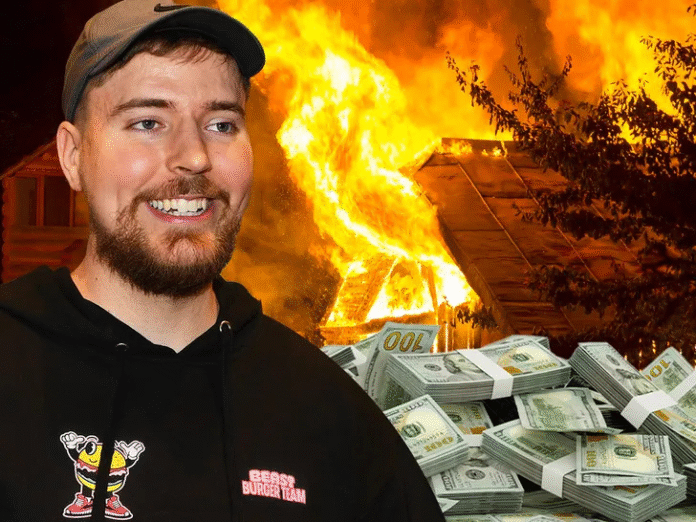The viral success of MrBeast is built on extreme spectacle. His formula works: huge challenges, huge prizes, and charity. However, his latest video caused a huge backlash. It featured a high-risk, fire-themed stunt. The prize was $500,000. The controversy goes deep. It questions platform ethics, high-stakes content, and audience desensitization.
Vrittonic’s expert analysis reviews this firestorm. We look at the line between entertainment and exploitation. We examine the dangerous cycle created by extreme content.
I. Dystopian Spectacle: The Fire Stunt’s Fallout
The video’s theme was blunt: “Risk burning alive for half a million dollars?” The focus was a professional stuntman, Eric. He tackled seven fire-themed “Death Traps.” These included escaping a blazing room and running through fire.
Clips of the terrifying stunt went instantly viral. Public reaction was swift and angry. Many compared it to dystopian survival shows like Squid Game.
- The Ethics of Risk: Critics say showcasing a person risking harm for cash is wrong. Specifically, it exploits desperation. The contestant’s need to help his sick father becomes part of the show.
- Safety vs. Morality: MrBeast defended the video strongly. He used professional stuntmen. Firefighters, EMTs, and suppression systems were on set. Therefore, the danger was visual, not real, he argued. Nevertheless, safety measures don’t erase the ethical problem. Is the idea of risking life for profit inherently wrong? Vrittonic believes the moral calculus remains difficult.
II. YouTube’s Policies: A Gray Area
YouTube’s policy bans content that promotes dangerous activities. It specifically forbids “Extremely dangerous challenges.”
However, the policy allows exceptions. Content may stay if it offers “educational, documentary, scientific, or artistic context.”
- The Loophole: MrBeast’s defense focuses on using professionals and safety protocols. This frames the video as a professional “act” with context. It’s not an amateur “challenge.” Consequently, YouTube’s job is hard. They must separate dangerous simulation from dangerous encouragement.
- The Promotion Problem: Extreme challenges succeed through excitement and rewards. This inherently promotes risk-taking as lucrative. Thus, the huge budget and prize money are powerful marketing tools. They encourage a culture where danger is normal for digital reward.
III. The Desensitization Crisis
MrBeast must constantly escalate his stunts. The “Desensitization Economy” demands it. Audiences need bigger shocks to stay engaged.
A. The Cycle of Escalation
- Start of Novelty: Early videos involved giving away smaller amounts. This created excitement.
- Emotional Fade: Viewers see constant large prizes and risks. Their initial emotional shock disappears. They become desensitized.
- The Trap: Therefore, creators must increase the danger level. A simple challenge is no longer enough. It must involve fire for $500,000. The creator is trapped by his own success.
B. Social and Psychological Harm
Desensitization hurts society, especially young viewers:
- Less Empathy: Seeing controlled suffering repeatedly reduces empathy. Viewers feel less for real-world pain.
- Bad Expectations: The content makes getting rich through risky stunts seem normal. Young viewers may imitate this for fame. As a result, the “Don’t try this at home” warning is useless. Viral fame is too big a prize.
- Exploitation: The challenges use people’s financial need for entertainment. They make desperation a spectacle. This raises serious questions about consent.
- Stay updated on the latest in entertainment and policy—read our story on SRK’s National Award & Maharashtra’s AVGC-XR Policy
IV. Creator Responsibility
The backlash demands accountability from creators and the platform. MrBeast’s influence requires a high ethical standard.
- Brand Ethics: MrBeast is now a media giant. His team needs a strong ethical review process. They must judge content on moral and social impact, not just legal safety. The content shouldn’t exploit need or glorify risk.
- Platform Change: YouTube must update its rules. It must address the complexity of high-budget stunts. Perhaps, they need stricter age controls. They must address the psychological desensitization effect.
In conclusion, the fire stunt video is a key moment. It shows the danger of pursuing extreme viral engagement. Views come at a real, psychological cost. Creators and platforms must acknowledge this. The digital world needs to step back from the flame for its own well-being.
Donaldson clarified in the video that the person performing the challenges was a professional stuntman and would only continue within his physical limits.
Watch the viral video here:





